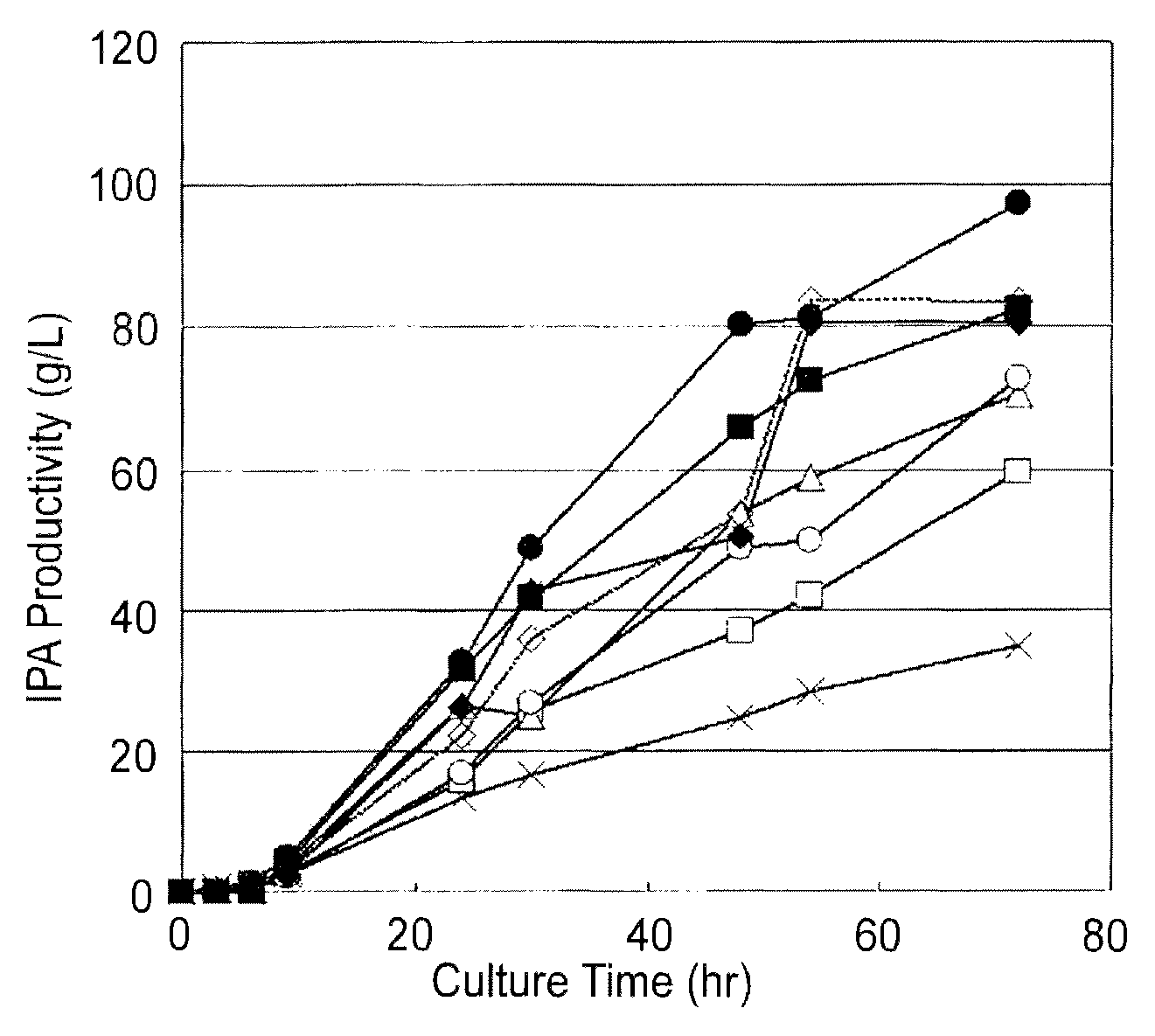Highly productive isopropyl alcohol-producing bacterium
a technology of isopropyl alcohol and isopropyl alcohol, which is applied in the direction of enzymology, organic chemistry, transferases, etc., can solve the problem of inability to completely suppress the amount of glucose consumed by secondary reactions, and achieve enhanced nad(p)+ transhydrogenase activity, enhanced enzyme activity, and enhanced malate dehydrogenase activity
- Summary
- Abstract
- Description
- Claims
- Application Information
AI Technical Summary
Benefits of technology
Problems solved by technology
Method used
Image
Examples
example 1
[B::pntA]: Production of Escherichia Coli B pnt Genome-Enhanced Strain
[0116]A pntA gene promoter in the genome of an Escherichia coli B strain was substituted with a GAPDH promoter to enhance the expression of pntA gene.
[0117]The entire base sequence of the genomic DNA of an Escherichia coli MG1655 strain is known (GenBank accession number U00096), and the base sequence of a gene encoding an NAD(P)+ transhydrogenase (AB-specific) α subunit of Escherichia coli (which may be hereinafter abbreviated to pntA) has also been reported (GenBank accession number X04195). In addition, it is known that pntA and a membrane transhydrogenase β subunit (pntB) form an operon in the genomic DNA of Escherichia coli MG1655 strain.
[0118]As a base sequence of a promoter necessary to allow the expression of the gene, a promoter sequence of glyceraldehyde 3-phosphate dehydrogenase (which may be hereinafter referred to as GAPDH) derived from Escherichia coli described in 397 to 440 in the base sequence inf...
example 2
[pGAP-Iaaa / B::pnt]: Preparation of Escherichia Coli B pnt Genome-Enhanced Strain to which Expression Vector for Escherichia coli-Derived Thiolase Gene, Escherichia coli-Derived CoA Transferase Gene, Acetoacetate Decarboxylase Gene Derived from Bacterium of the Genus Clostridium, and Isopropyl Alcohol Dehydrogenase Gene Derived from Bacterium of the Genus Clostridium was Introduced
[0126]An isopropyl alcohol-producing Escherichia coli having enhanced expression of NAD(P)+ transhydrogenase (AB-specific) gene (pnt) was prepared as follows.
[0127]The B::pnt strain produced in Example 1 was transformed with pGAP-Iaaa described in Example 4 of WO2009 / 008377, to obtain a pGAP-Iaaa / B::pnt strain. The pGAP-Iaaa is an expression vector plasmid capable of enhancing the expression of an Escherichia coli-derived thiolase gene, an Escherichia coli-derived CoA transferase gene, a Clostridium acetobutylicum-derived acetoacetate decarboxylase gene, and a Clostridium beijerinckii-derived isopropyl alco...
example 3
[B::atoDAB]: Preparation of Escherichia coli B atoDAB Genome-Enhanced Strain
[0128]The CoA transferase genes (atoD and atoA) and the thiolase gene (atoB) derived from Escherichia coli form an operon in the genome of the Escherichia coli in the order of atoD, atoA, and atoB (Journal of Baceteriology Vol. 169 pp 42-52 Lauren Sallus Jenkins et al). Accordingly, by modifying the promoter of atoD, the expression of the CoA transferase gene and the thiolase gene can be simultaneously controlled. Thus, the promoter of atoD gene in the genome of the host Escherichia coli was substituted with the GAPDH promoter to prepare an Escherichia coli having enhanced expression of atoD gene, atoA gene, and atoB gene.
[0129]The entire base sequence of the genomic DNA of the Escherichia coli MG1655 strain is known (GenBank accession number U00096), and the base sequence of a gene (which may be hereinafter abbreviated to atoD) encoding a CoA transferase α subunit of the Escherichia coli MG1655 strain has a...
PUM
| Property | Measurement | Unit |
|---|---|---|
| temperature | aaaaa | aaaaa |
| temperature | aaaaa | aaaaa |
| pH | aaaaa | aaaaa |
Abstract
Description
Claims
Application Information
 Login to View More
Login to View More - R&D
- Intellectual Property
- Life Sciences
- Materials
- Tech Scout
- Unparalleled Data Quality
- Higher Quality Content
- 60% Fewer Hallucinations
Browse by: Latest US Patents, China's latest patents, Technical Efficacy Thesaurus, Application Domain, Technology Topic, Popular Technical Reports.
© 2025 PatSnap. All rights reserved.Legal|Privacy policy|Modern Slavery Act Transparency Statement|Sitemap|About US| Contact US: help@patsnap.com


